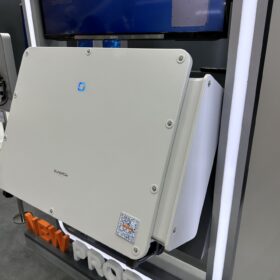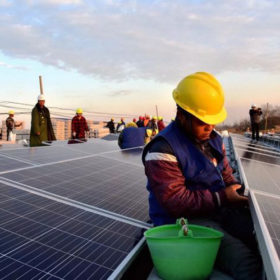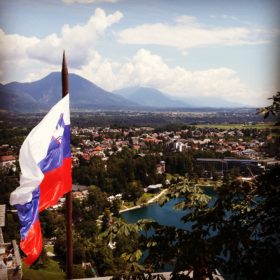Top News
Sodium-ion batteries face uphill struggle to beat lithium-ion on cost

Sungrow launches new inverter for C&I applications

Chinese PV Industry Brief: Three Gorges opens bids for 2.5 GW of n-type TOPCon
Follow pv magazine now on Instagram
MediaKit 2025
pv magazine Webinar
pv magazine Webinar

Masdar, EWEC announce 5 GW/19 GWh solar-plus-storage project in Abu Dhabi

European prosecutor probing fraudulent solar scheme in Slovenia
BrightNight switches on first phase of 115 MW hybrid wind-solar power project
Greece launches C&I battery storage subsidy program
GoodWe unveils hybrid inverters for homes with weak wireless service
Press Releases
SMART ENERGY WEEK [February] 2025 reveals conference lineup & new exhibit area
Huasun Marks 10 GW in Global Shipments, Ushering in New Chapter for HJT Solar Technology
AIKO Partners with Nordlys NTNU to Drive Solar Innovation in the World Solar Challenge
Solis Inverters Now Listed on Hawaiian Electric’s Qualified Equipment List
Opinion & Analysis
Featured
The fastest energy change in history continues
European solar market 2024-2025: balancing growth, challenges and opportunities
Markus Hoehner and Rajan Kalsotra, CEO and Senior Consultant at the Bonn-based EUPD Research, discuss the growth trajectory, challenges and opportunities within the EU solar PV market, focusing on policy support, pricing trends, module shipments and future projections.
GPM awaits tariff support, Chinese polysilicon futures injects boost
In a new weekly update for pv magazine, OPIS, a Dow Jones company, provides a quick look at the main price trends in the global PV industry.
From equality to equity: powering inclusive leaders in the solar sector
This week, Women in Solar Europe (WiSEu) reflects on the need for tangible DEI practices and inclusive leaders who understand the meaning of equity and diversity to create inclusive environments that acknowledge individual needs and systemic barriers. Addressing these aspects is critical to fuel innovation, creativity, and resilience to overcome the challenges of our sectors in the energy transition.
Bright US Midwest contrasts with cloudy coasts in 2024
In a new weekly update for pv magazine, Solcast, a DNV company, reports that the US Midwest enjoyed exceptional conditions with irradiance up to 10% above normal across the year, while areas along the Gulf Coast and much of the West Coast experienced slightly below-average sunshine.
How to measure industry’s carbon footprint
The IEC has launched a new portfolio of carbon footprint verification services to help build trust and credibility in companies’ commitment to monitoring and reducing their emissions.
Markets & Policy
Featured
Bluetti launches new home battery storage options
Latin America’s largest PV plant expands to 1.6 GW
Elera Renováveis has commissioned the third phase of the 1.6 GW Janaúba solar complex in Brazil. The facility, which went online this week, consists of 27 solar parks spread across 3,800 hectares.
Sodium-ion batteries key for India’s storage manufacturing ambitions
A new report says sodium-ion batteries (SIBs), made from abundant materials, could help India to reduce its dependence on imports to meet its energy storage needs.
U.S. solar panel supply ‘sufficient’ but two bottlenecks hold industry back
Solar panel supply is no issue, but other installation bottlenecks have emerged, said a report from Clean Energy Associates.
Taiwan to add 8.2 GW of solar, offshore wind by end of 2026
Taiwan’s Ministry of Economic Affairs (MoEA) has launched a wind and solar energy improvement plan in a bid to reach an existing target of 20 GW of deployed solar by the end of next year.
Where will lithium-ion battery prices go in 2025?
After tumbling to record low in 2024 on the back of lower metal costs and increased scale, lithium-ion battery prices are expected to enter a period of stabilization.
Installations
Featured
Solar accounts for 11.9% of Belgium’s 2024 electricity mix
Romania’s Electrica launches solar tenders
Romanian utility Electrica Group has launched two solar tenders, including a 62.5 MW project open for applications until Jan. 31 and a 77.6 MW project open until Feb. 17.
Ukraine adds over 800 MW of solar in 2024
The Solar Energy Association of Ukraine says the country installed 800 MW to 850 MW of solar capacity in 2024, driven mainly by business and residential installations.
Carrier launches new air-to-water heat pumps for residential, commercial applications
Carrier, a US-based heating solutions provider, has introduced a new 4-14 kW line of heat pumps with a coefficient of performance of up to 4.90. The system use propane as the refrigerant and can reportedly reach leaving water temperature of 75 C.
Energy communities should be supported via network tariff adjustments
New research from Belgium shows that energy-sharing alone is not attractive enough for citizens and businesses willing adopt solar through an energy community. According to the study, policy support for energy communities should take the form of network tariff adjustments reflecting the community’s measurable benefits for the distribution grid.
How to achieve higher power yield in east-west oriented solar arrays deployed on flat roofs
Researchers in Switzerland investigated different setups to maximize energy yields per area for PV Systems on flat roofs. Their work revealed that using horizontal single-axis tracking and reflectors could add up to 5% greater performance.
Technology
Featured
Huasun debuts 720 W solar modules for vertical PV projects
Chinese startup unveils flexible perovskite photovoltaic modules with 15.6% efficiency
Mellow Energy claims its ML-Flex panel is currently the world’s largest flexible perovskite solar module. Available in five versions with power output ranging from 260 W to 300 W, the module measures 1,200 mm x 1,600 mm and weighs only 2.04 kg.
Inverted perovskite solar cell based on self-assembled bilayer achieves 26.08% efficiency
The proposed bilayer is used as a hole contact material that ensures an improved adhesive contact with the perovskite film. It consists of a phosphonic acid self-assembled monolayer with an upper layer made of an organic compound known as triphenylamine.
The impact of wind-induced vibrations on solar modules
Researchers from the UAE and Singapore have assessed how wind-induced vibrations increase mechanical stress in PV panels and have found these vibrations could lead to microcracks, more serious mechanical failures, misalignments, and ultimately to the system collapse.
Researchers develop high transparency nanocellulose film for photovoltaics, packaging
The nanocellulose film can be used for light management as its light scattering is adjustable. It also exhibits a transmittance of over 80% at 550 nm.
Microvast reveals all-solid-state battery tech with operational voltage of 12-21 V
Microvast says its new True all-solid-state battery (ASSB) eliminates liquid electrolytes to achieve voltages of 12 V to 21 V, with a bipolar stacking design that cuts interconnections between cells, modules, and packs.
Manufacturing
Featured
China reviewing anti-dumping duties on solar-grade silicon from US, South Korea
Daytime radiative cooling tech for solar panels
A Chinese research group has created a new radiative cooling technology for photovoltaic devices. It consists of a chamber made of ethylene-tetrafluoroethylene and polydimethylsiloxane that, when placed above the solar cells, can reportedly achieve an average cooling power of approximately 40 W/m2.
Organic solar cells for space demonstrate radiation resistance, self-healing
Conventional silicon solar cells degrade rapidly in space, and gallium arsenide cells are heavy and inflexible. Research from the University of Michigan suggests carbon-based solar cells could be a good fit for space applications.
Italy increases incentives for EU-made solar modules
Italy has expanded incentives for PV projects using EU-made modules under its Transizione 5.0 Tax Credit scheme, offering up to 35% coverage and higher calculation bases for high-efficiency cells and modules.
Chinese PV Industry Brief: Aiko Solar starts making back contact PV panels
Aiko Solar has started production at its Jinan factory, its third facility for n-type all-back-contact solar modules. The plant is designed for 30 GW of solar cell and panel capacity, with the first 10 GW phase set to reach full output by late 2025.
Firefighter injured in solar-plus-storage explosion and fire in Spain
The fire, which affected a photovoltaic installation in a container with batteries at the port of Gandia, started at 6:14 p.m. on January 4.
Energy Storage
Featured
World’s largest compressed air energy storage facility commences full operation in China
Japan keeps lead in solid-state battery development
While China, South Korea, Europe, and the United States are also engaged in active development of all solid-state batteries, Japan is leading the charge, offering generous subsidies to technology proponents.
Solar discovery could transform hydrogen production
An international study led by Flinders University in Australia has advanced nanoscale chemistry to further develop sustainable and efficient generation of hydrogen from water using solar power.
Chinese scientists design hybrid heat pump providing ultra-high temperature heating at 180 C
The proposed system uses waste heat by thermally coupling a water lithium bromide absorption heat transformer with a water vapor compression heat
pump. It reportedly achieved a temperature elevation of up to 110 C and ultra-high temperature heating of up to 180 C.
SolarEdge launches AI-based energy management system
The controller integrates selected third-party products into the SolarEdge EMS ecosystem by connecting to a household’s internet router via the local area network (LAN). It can communicate with inverters, electric vehicle chargers, heat pumps and SolarEdge’s servers.
World’s largest pumped storage power plant fully operational in China
The plant features 12 reversible pump-turbine units, each with a capacity of 300 MW, including two variable-speed units, bringing the total installed capacity to 3.6 GW.




